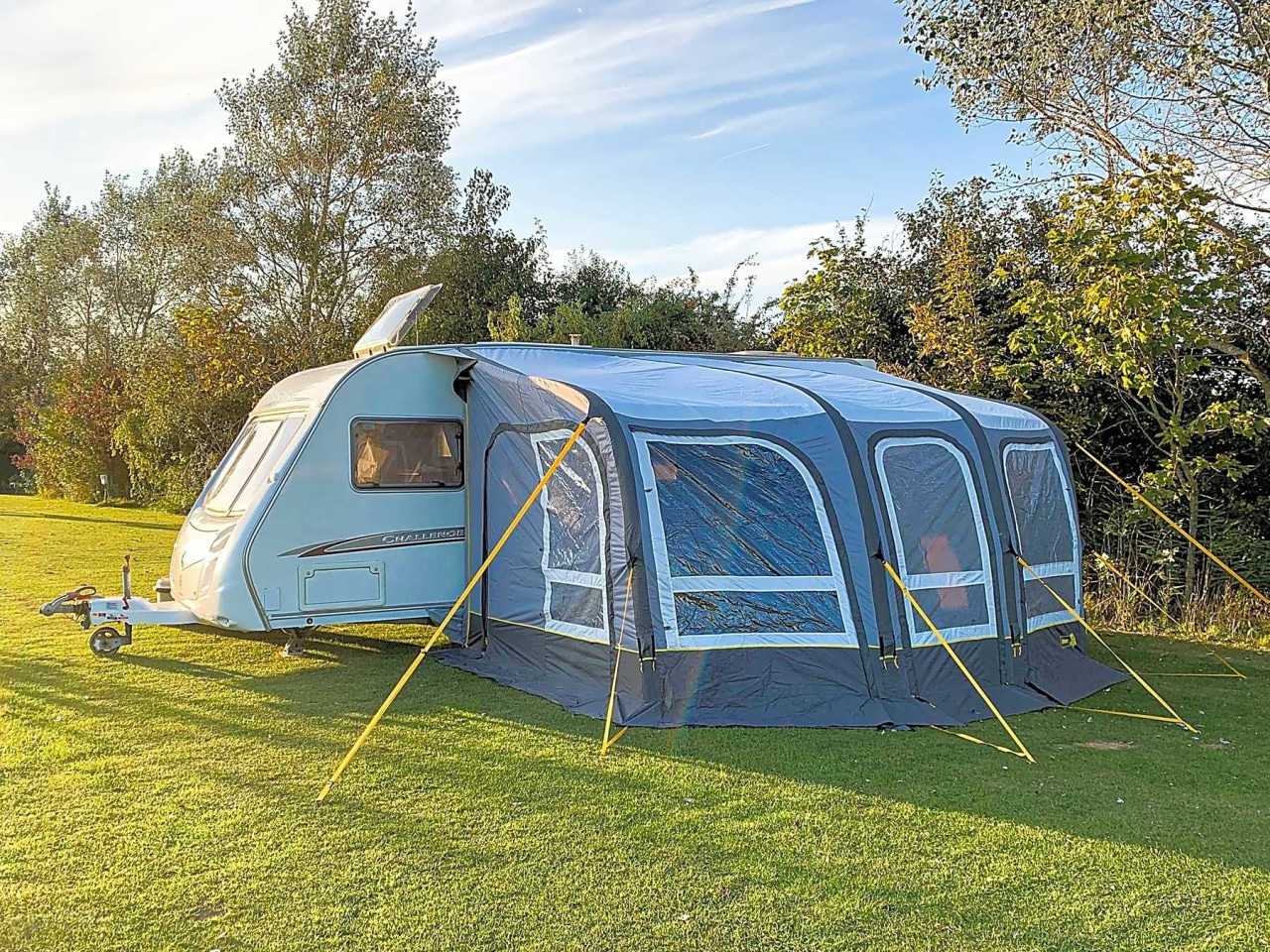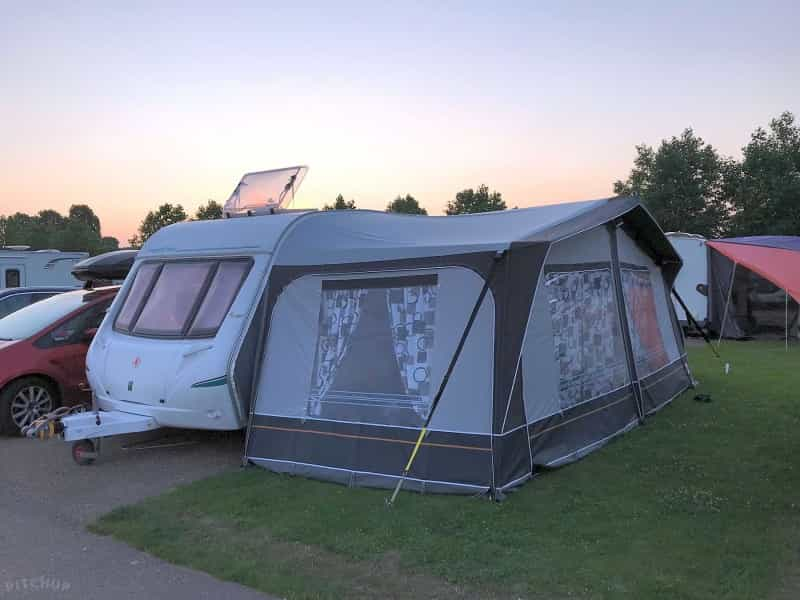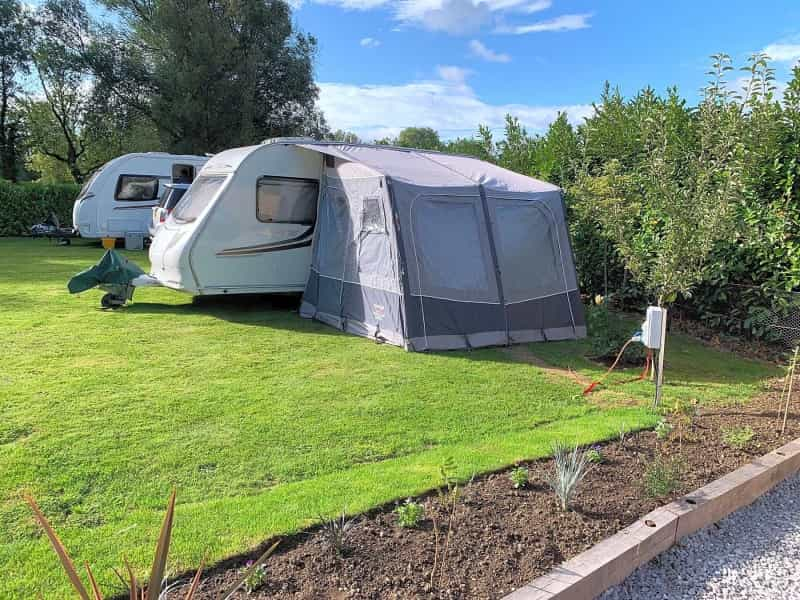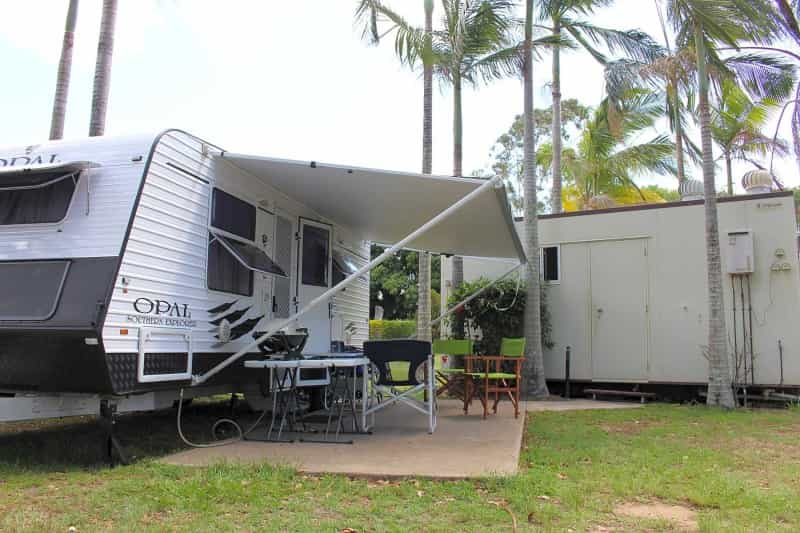Caravan awnings
If you’re weighing up the benefits of a caravan awning, there’s a lot to consider. Caravan awnings have many perks, from creating extra living and storage space to providing somewhere peaceful and sheltered where you’re free to spy on the local wildlife and sunsets. First, though, you’ll need to work out exactly what type of awning suits your needs and assess the benefits of adding each one to your caravan set-up.

So that you’re well-prepared and you know exactly what to expect out of your caravan awning, we’ll be covering all of the above, as well as how to measure for a caravan awning and the simplest way to put it up.
Benefits of using an awning when caravanning
They add extra living space.
One of the biggest benefits of having a caravan awning is that they create extra living space. Whether it’s the ability to set up a table to eat alfresco , or having a space where you and your guests can talk, play games or enjoy evening drinks, an awning can add a lot of value to your caravan set-up.
Caravan interiors are notoriously short on space, so awnings will help you to feel less cramped, especially when there are multiple people staying in the caravan.
They create extra storage space.
With all that additional space also comes extra storage space. An awning is a great storage solution, especially when it comes to disposing of clothes, coats and shoes or finding a place for excess cooking equipment, barbecues, torches and firewood.
As an outdoor space, an awning is a better option for storing things like wellies and muddy or sandy equipment than the inside of your caravan, where you’ll have a bigger clean-up ahead of you.
Awnings can protect your belongings from bad weather.
Many caravanners already dump shoes, clothes, coats and equipment outside of their caravan, and this often results in soggy or blown-away belongings when the weather suddenly takes a turn for the worse. Although awnings are located outside, they provide greater shelter from light or moderate wind and rain.
They add privacy to your pitch.
One great way to prevent nosey neighbours or passersby looking in on your pitch is by putting up a caravan awning. Many caravan awnings feature curtains or removable panels that can be closed up when you fancy some privacy.
They let you enjoy the scenery.
Surrounded by the four walls of your caravan, unless you’re permanently stationed by a window, you don’t have a great view of the outside world. When you’re staying somewhere new, and likely somewhere with interesting scenery too, an awning will let you enjoy the view. This is especially the case with a canopy awning, which sits overhead and provides a clear view of the landscape.
They’re easy to set up.
You might want to skip to our section on how to put up your caravan awning for the full details, but overall, setting up a caravan awning shouldn’t require too much work. It’s usually just a two-person job – although this depends on the size of your caravan. Your user manual will provide more detailed instructions for your model.
You may need to charge your leisure battery less often.
When you’re enjoying the outdoors, albeit under the cover of an awning, it’s likely you’ll be spending less time using the electricity in your caravan to do things such as watch TV or light the room. That’s reflected in how often you need to charge your leisure battery and it may even help you transition into staying on caravan pitches without the option of electric hook-up facilities.
The different types of caravan awnings
Awnings can come in many different types, sizes and styles. Which one you choose is completely up to personal preference and your available space, but each type does have a set of pros and cons.
1. Full awning
A full awning is fitted to the whole circumference of one side of your caravan. Since they attach to the full length of the awning rail and stretch all the way to the ground, a full awning can significantly extend your living space, and it may look a lot like a tent.

Pros:
-
The largest type of awning, so it significantly extends your living space.
-
Adds a generous amount of storage space.
-
Full-length walls add privacy to your pitch.
-
Keeps out light or moderate wind and rain.
-
Usually comes with a groundsheet to protect from moisture from the ground.
-
Premium options have features such as extra bedrooms, removable panels and curtains.
Cons:
-
Heavier to transport.
-
Requires more time and effort to set up.
-
Without removable panels or curtains, you won’t have a clear view of the scenery.
2. Porch awning
Porch awnings attach to the horizontal section of the awning rail, rather than the full circumference of your caravan. They’re usually set up around a central area, including the caravan door, and they stretch all the way to the ground.

Pros:
-
Quicker to set up than full awnings.
-
Suitable for use on multiple different caravan models.
-
Enough space to to dispose of shoes and equipment such as bicycles or beach gear.
-
Slightly lighter to set up and transport than full awnings.
-
Usually come with a groundsheet to protect from moisture from the ground.
-
Effective protection from light or moderate wind and rain.
-
A good level of privacy with walls that stretch to the ground.
Cons:
-
Less living space than a full awning, especially if you’re already using the porch awning for storage purposes.
-
May cause issues if the sides of the awning pass through the middle of windows and vents in your caravan.
3. Canopy awning
Canopy awnings attach horizontally to the top of your caravan and provide shelter from the sun and other elements. They are typically supported by two poles that either attach to the bottom corners of your caravan or fold down to the ground.

Permanent canopy awnings can be fixed to the side of your caravan by a specialist. They act a lot like window blinds; when you want to use the awning, it can be rolled down and supported by two built-in foldable poles.
Pros:
-
A simple design that’s easy to set up and put away.
-
Provides basic shelter from rain and sun.
-
Gives a clear view of the scenery at all times.
Cons:
-
The smallest type of caravan awning.
-
Rain may still wet belongings stored under a canopy awning depending upon the angle of the rain and the wind.
-
No walls or curtains for privacy, unless you order detachable fabric walls.
4. Inflatable awnings
An inflatable awning is supported by air rather than rigid poles. It may fall under the bracket of a full, porch or canopy awning.
Pros:
-
Light and easy to transport.
-
Quick and easy to set up.
Cons:
-
Requires you to carry an upright or battery-powered air pump.
-
May deflate if damaged.
Awning materials
The material of your caravan awning also plays an important role. Ideally, you want your awning to be durable, long-lasting and resistant to rain and UV rays.
Pole materials
Steel: Steel poles are the most durable and will withstand rain and light wind. However, they are heavier to carry and require more elbow grease to set up, making them a wiser option for caravanners who usually stay in one location for long periods of time.
Aluminium: Aluminium poles are lighter in weight, making them easier to transport and set up, so they're more suitable for caravanners who relocate frequently. Howevere, they aren’t quite as durable as steel poles, so they won’t last as long and they may have more difficulty withstanding windy or rainy conditions.
Fibreglass: Similar to aluminium, fibreglass poles are also light to carry and add to the ease of setting up the awning. They’re not as durable or as long-lasting as steel poles.
The fabrics
The following fabrics are the most common fabrics found in caravan awnings:
Lightweight polyester: Lightweight polyester is quick to dry and easy to transport or store. Since it’s lighter in weight, it’s also easier to set up. However, it doesn’t last as long as heavy-duty polyester.
Heavy-duty polyester: Heavy-duty polyester is your best bet if you’re caravanning for long periods of time. While it does weigh slightly more than lightweight polyester, the payoff is a durable fabric that will stand the test time.
Acrylic: Acrylic awnings are pricier than polyester awnings. They also have a rigid appearance. As the appearance would suggest, they’re extremely durable, and solution-dyed acrylic fabrics are also resistant to UV light. An acrylic awning will last longer than a polyester awning, even if you stay in your caravan throughout the year. They’re also resistant to moderate rainfall.
Having a water resistant awning is important if you often go caravanning in rainy or very sunny climates. While most caravan awnings aren’t intended for use in heavy rain, both polyester and acrylic materials are woven materials that provide some resistance against light or moderate rain and UV rays.
Acrylic fabric is slightly more resistant against rain and UV rays than polyester fabrics. Other laminated awnings also provide a good level of protection from water and moisture.
How to measure for a caravan awning
How do I measure for a full awning?
When you’re buying a full awning, you’ll need to look up your caravan’s ‘A’ measurement in the handbook. If you can’t find the figure, measure the length from the floor at the front end of your caravan, tracing the length of the awning rail to the floor at the back end of your caravan. The final measurement should fit within the size range of your chosen full awning, detailed in the product description.
The depth of the awning relates to how far the awning will stretch away from your caravan. The greater the depth, the more space you’ll have, but the bulkier the awning will be to set up and transport.
How do I measure for a porch awning?
Measuring for a porch awning is a little different. The main measurement you’ll need is the height of the caravan: in other words, the space between the top of the awning channel and the ground.
When it comes to choosing the length of your awning, you should think about caravan features such as windows or vents that the awning may cut off. For instance, you don’t want the awning’s walls to interfere with your ability to open an important vent or window.
How do I measure for a canopy awning?
To fit a canopy awning across the full horizontal length of your caravan, you will need to measure the length of the horizontal section of your awning rail. This is the area at the top of the caravan, from left to right. The depth of the canopy awning dictates how far the awning will stretch out to the side of the caravan.
How to put up a caravan awning
With the following easy-to-follow steps, putting up a caravan awning should be quite straightforward. The result? A sturdy structure that will stay put for your entire holiday.
Your caravan awning will also come with its own set of instructions which you should follow as closely as possible; the following steps can be used as a basic guide. Usually, you also don’t need any special tools as long as your awning rail is in good condition – just a little bit of elbow grease and some lubricant (and ideally, a second person to help you).
1. Lay out your groundsheets.
If your awning comes with a groundsheet, you should start by laying this down in front of your caravan. Using a small hammer or the heel of your foot, it may help to hammer the pegs into the ground lightly to prevent it from being blown away while you set up your awning.
2. Check that the awning rail is free from obstructions and in good condition.
The last thing you want is a stray twig or other debris catching and ripping your awning fabric while you set it up. So, the first thing you need to do is check that the awning channel (located around the edge of your caravan) is free from any obstructions.
The rail should also be in good condition. If the channel gap has collapsed anywhere, you will need to use an awning rail spreader to fix the problem, or prise it open with a wedge of wood. Any sharp corners can be filed down with sandpaper. If this doesn’t work, you might need to replace the entire rail.
3. Lubricate the awning channel.
While this step is optional, applying an awning channel lubricant or a silicone-based furniture polish to the awning rail will help you to thread the awning cord through the channel without it getting stuck.
4. Feed the awning cord through the channel.
There are two entry/exit points on the awning channel. Start by feeding the awning cord through the entry point at the rear of the caravan and guiding the cord through the channel until it reaches the other entry/exit point.
This is typically a two-man job. One person might need to work out snags (using a step ladder if they’re unable to reach the top of the rail) while the other gently feeds the cord through the entry point.
5. Position the awning cord centrally.
Once the cord has been fed through the channel, make sure that there is an equal length of cord at the entry and exit point on the awning channel.
6. Set out your poles.
The hardest part of setting up a caravan awning is often working out which pole goes where. Using your manual, you’ll want to divide your poles into three main sections and then set out a basic plan of the frame on the ground.
The front frame is made up of vertical poles that act as legs and poles that form the front and left sections. The third and final section consists of poles for the roof; these poles have hooks so that they can be attached to the caravan.
7. Consider whether you need to add extra features such as the draught skirt, wheel arch cover and curtains.
Depending on the type of awning and the instructions in your manual, you might need to add features such as a draught skirt, wheel arch cover or curtains when you’re setting up your awning.
When you add these features depends upon the make of your awning, so you should take this time to assess how and when you should add these features. Ensure that they are all securely attached to the awning using the instructions provided in the manual; otherwise, they might get blown away.
8. Build your poles.
While you should follow your manual’s instructions, as a general guide, you should begin by setting up the central poles and working outwards. This could mean beginning with setting up the central leg pole and attaching the central roof pole, before moving onto the side sections and front sections.
When you’re setting up the legs of the awning, be sure to angle the legs slightly towards your caravan. This will create a more stable frame.
Using the clamps on the poles, also adjust the leg heights so that each pole sufficiently supports the awning and it doesn’t stretch or sag the material. The top of the awning should be horizontal to the ground.
9. Add any canopy tension poles.
Some awnings may have canopy tension poles to protect the fabric between the pole and canopy. These can be attached to your awning once your poles are set up.
10. Add any front or side panels.
With the frame of your awning put together and secured, you should use the zips provided to add in any front or side privacy panels.
11. Secure pegs and/or guy ropes.
Your awning might come with pegs or a combination of guy lines and pegs. These are an essential part of setting up your awning, because they keep the structure secure and prevent it from being blown away.
If you’re using pegs, hammer them into the peg points at an angle. For awnings where both guy ropes and pegs are provided, you should angle and extend the guy lines away from the centre point of the awning and secure them to the ground by hammering the pegs into the ground at an angle.
Any guy lines should be taut, but not overly tight. It may help to cross over the pegs at the base of the structure for extra stability.
Now that you’ve set up and secured your awning, you’re ready to unwind and enjoy all the extra outdoor space that your new setup has created. However, the improvements don’t need to end there: our guides to caravan accessories, how to get a good TV signal in a caravan and caravan wastewater may also come in handy.
Browse our guide to caravanning
FAQ
Do caravan awnings fit all caravans?
Caravan awnings come in many different sizes to fit all different types of caravans. However, less common awnings such as inflatable awnings might need to be specially made for your caravan.
What is the best type of caravan awning?
While a full awning creates the most living and storage space, porch awnings or inflatable awnings are easier to transport, put up and take down. Canopy awnings are also helpful as a basic shelter that provides a clear view of the scenery and keeps off some sun and rain.
How do I work out what size awning I need for my caravan?
Find your caravan’s ‘A’ measurement in the handbook or measure the length of the awning rail from the floor at the front end of your caravan to the ground at the back end of your caravan. The final measurement should fit within the size range of your chosen awning.
How long do caravan awnings last?
How long your caravan awning lasts depends on the material, storage, weather conditions and the length of time they are used for. Typically, a caravan awning can last anywhere between a couple of months to several years when it is stored correctly and used moderately.